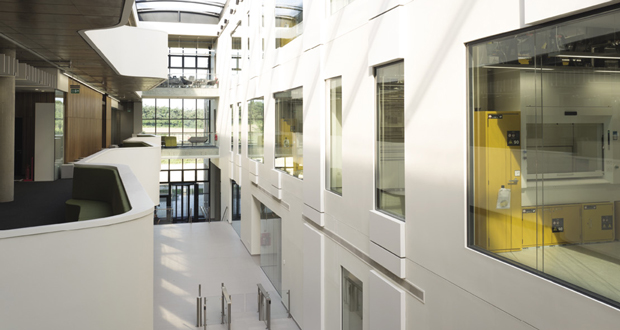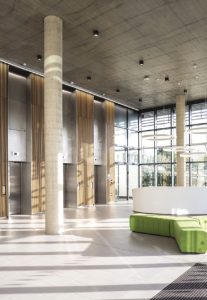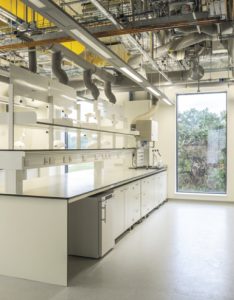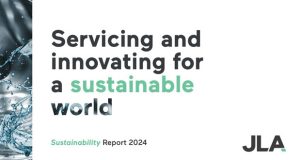Designing and managing a building with collaboration at its heart has been key to the success of a landmark healthcare research facility. Richard Walder, Sector Director of Science and Technology (UK) at Buro Happold(i) and Nora Claudio Familiar, Project Architect at NBBJ(ii), explain how it was achieved through building design
The Quadram Institute(iii), a landmark healthcare research facility in the heart of Norwich’s science park(iv), brings three very different and unique healthcare and research organisations under one roof. This created a number of challenges for the design and facilities management teams. It was fundamental to strike the right balance between designing a space used by multiple organisations and creating a facilities infrastructure suitable for all.
The first of its kind in Europe, the £75 million Quadram Institute provides a space that encourages greater collaboration between three resident organisations – the former Institute of Food Research (now Quadram Institute Bioscience), research departments from the University of East Anglia(v) and the Norfolk & Norwich University Hospital (NNUH) endoscopy department(vi) – while providing state-of-the art facilities for NHS patients. The project was designed by a team led by international science and healthcare design architects NBBJ and integrated engineering consultancy Buro Happold.
The 14,000m2 building is home to 300 researchers exploring the relationship between diet and disease, along with 100 clinicians and support staff. It incorporates a new Clinical Research Facility that hosts research studies into a range of health conditions, involving patients and volunteers. The building also welcomes 40,000 patients each year at the largest colorectal surgery and gastrointestinal endoscopy unit in Europe.
ENHANCING THE WORKING ENVIRONMENT
To design and develop the Quadram Institute it was essential to understand the use and governance requirements of each organisation from the outset, so the design team addressed the challenge by regularly meeting key members from each organisation. The team worked with over 50 client-side users during design and construction, including researchers, laboratory managers, PhD students, clinicians, nursing staff and senior managers. This ensured a broad understanding of the requirements for each organisation, together with essential standards and regulations. As well as coping with Health Technical Memoranda (HTMs) and individual requirements for each client, the team also had to pay careful attention to the vast amount of specialist equipment onsite; this includes Containment Level 2 and Containment Level 3 laboratories, which have very strict security and operational requirements.
The concept design stages were interactive and consultative, comprising a series of design workshops, meetings and presentations to users and the wider stakeholder groups to discuss aesthetic, operational, technical and security details. This process was essential in identifying common ground as the three organisations, understandably, did not wish to compromise on the core functions of each space. There was a strong desire for each to retain its own identity within the building, to work independently, while also looking for opportunities to interact with one another.
The intensive briefing captured the key challenges for the design team: creating a welcoming environment for the public and patients while ensuring that research work would not conflict with patients’ positive experience. Security and people movement were also crucial, to ensure that the public did not enter any restricted areas.
To tackle this problem, the team optimised the working environment to both improve operational functionality, and reduce energy consumption in laboratory spaces. By testing different scenarios using Buro Happold’s Lab Analytics tool, which analyses people flow, the team examined which entrance layout worked best to establish clarity and wayfinding for the public, hospital staff, and researchers.
CULTIVATING COMMUNICATION, COLLABORATION AND CREATIVITY
As well as finding the best layout to direct the flow of visitors and staff through the building, the design team used the people flow analysis to create a building which encourages more communication – and therefore collaboration – among the staff, identified as one of the Quadram Institute’s primary goals.
Studies on workplaces and labs have shown that several factors impact the quality and efficiency of working environments. These factors include the quality of the spaces, the organisational structure and culture, communication patterns, types and diversity of people employed and operational processes. So, combining these factors and studying them provides a powerful, holistic assessment of the effectiveness of the research environment.
Therefore, as well as looking at the entrance layouts, the team were also able to look at connections and stopping points that could help to ‘engineer’ those chance meetings and encourage people to communicate – and, potentially, to collaborate. By increasing the number of opportunities for these ad hoc interactions, the environment becomes more appealing to people, which leads to increased productivity and quality of outputs.
Having this analysis meant that each client received a diverse range of options, which they could use to refine their strategic, design and operational decisions, focused on maximising research effectiveness.
The team identified early on that lines of visibility are fundamental to a building that aims to encourage and stimulate collaboration. Large glazed openings provide crucial lines of sight from office desks to laboratory benches and between floors across the atrium light well. By reducing the number of cellular offices, the open plan interior frees up space to create additional breakout areas, particularly around the atrium and link bridges. While the open-plan scheme exists throughout the building, the flexibility of these spaces allows each department to break up the space as needed.
Other design moves include the organisation and sharing of space in formal and informal ways. Different research groups are intentionally sharing office space, while meeting rooms and other building amenities are used collectively by occupants to encourage engagement between clinicians, researchers and both external UK and international collaborators. Common areas are also shared elements, which can be used by each partner on their own or together; hence, the building inspires inter-connection across the wider research park campus. In that respect, the ground-floor canteen offers an informal environment for conversation and the atrium provides additional space to host events and exhibitions.







